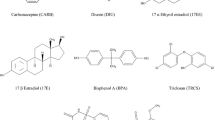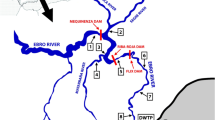Abstract
Concern about the presence of emerging contaminants in the environment has increased because biological activity at low concentrations has been observed. The difficulty of detecting and quantifying these compounds encourages the development of analytical methods with highly sensitive and selective analytical procedures. Pharmaceuticals, pesticides, and industrial chemicals are used and finally discarded to the environment. This paper provides a rapid and sensitive analytical method for the quantification of eight emerging contaminants (carbamazepine, carbofuran, bisphenol A, diuron, 17 α ethinylestradiol, ametryn, carbazole, and triclosan). A two-level full factorial design for optimization of chromatographic separation and sample preparation was performed. The separation using a monolithic column (Onyx C18) achieved baseline resolution for all compounds in 4.6 min. The optimized sample treatment involved a preconcentration step by means of solid-phase extraction using HF Bond Elut-C18 cartridges, achieving an enrichment factor of 2222. Under optimum conditions, good linearity was obtained with a correlation coefficient higher than 0.999. The limits of detection and quantification for carbamazepine, carbofuran, bisphenol A, diuron, 17 α ethinylestradiol, ametryn, and carbazole were in the range of 0.01–208.7 and 0.03–695.7 ng L−1, respectively, and for triclosan, the limit of detection and quantification was 0.67 and 2.25 μg L−1, respectively. Precision evaluated as relative standard deviations was lower than 15 %. The proposed method was found robust. Finally, the method was successfully applied to superficial water samples.



Similar content being viewed by others
References
Stuart ME, Lapworth DJ, Thomas J, Edwards L (2014) Fingerprinting groundwater pollution in catchments with contrasting contaminant sources using microorganic compounds. Sci Total Environ 468–469:564–577
La Farré M, Pérez S, Kantiani L, Barceló D (2008) Fate and toxicity of emerging pollutants, their metabolites and transformation products in the aquatic environment. Trends Anal Chem 27(11):991–1007
Eertmans F, Dhooge W, Stuyvaert S, Comhaire F (2003) Endocrine disruptors: effects on male fertility and screening tools for their assessment. Toxicol in Vitro 17(5–6):515–524
Stuart M, Lapworth D, Crane E, Hart A (2012) Review of risk from potential emerging contaminants in UK groundwater. Sci Total Environ 416:1–21
Perez Martin JM, Fernandez Freire P, Labrador V, Hazen MJ (2008) Carbamazepine induces mitotic arrest in mammalian Vero cells. Mutat Res 637:124–133
Bottoni P, Grenni P, Lucentini L, Caracciolo AB (2013) Terbuthylazine and other triazines in Italian water resources. Microchem J 107:136–142
Rodriguez-Mozaz S, Ricart M, Köck-Schulmeyer M, Guasch H, Bonnineau C, Proia L, De Alda ML, Sabater S, Barceló D (2015) Pharmaceuticals and pesticides in reclaimed water: efficiency assessment of a microfiltration–reverse osmosis (MF–RO) pilot plant. J Hazard Mater 282:165–173
Field JA, Reed RL, Sawyer TE, Martinez M (1997) Diuron and its metabolites in surface water and ground water by solid phase extraction and in-vial elution. J Agric Food Chem 45(10):3897–3902
Gupta RC (1994) Carbofuran toxicity. J Toxicol Environ Health 43(4):383–418
Pedrouzo M, Borrull F, Marcé RM, Pocurull E (2011) Analytical methods for personal-care products in environmental waters. Trends Anal Chem 30(5):749–760
Piccoli A, Fiori J, Andrisano V, Orioli M (2002) Determination of triclosan in personal health care products by liquid chromatography (HPLC). Il Farmaco 57(5):369–372
Silva ARM, Nogueira JMF (2008) New approach on trace analysis of triclosan in personal care products, biological and environmental matrices. Talanta 74(5):1498–1504
Clara M, Strenn B, Saracevic E, Kreuzinger N (2004) Adsorption of bisphenol-A, 17 beta-estradiole and 17 α-ethinylestradiole to sewage sludge. Chemosphere 56(9):843–851
Allmyr M, Adolfsson-Erici M, McLachlan MS, Sandborgh-Englund G (2006) Triclosan in plasma and milk from Swedish nursing mothers and their exposure via personal care products. Sci Total Environ 372(1):87–93
Esen F, Tasdemir Y, Sıddık Cindoruk S (2010) Dry deposition, concentration and gas/particle partitioning of atmospheric carbazole. Atmos Res 95:379–385
Gavrilescu M, Demnerová K, Aamand J, Agathos S, Fava F (2015) Emerging pollutants in the environment: present and future challenges in biomonitoring, ecological risks and bioremediation. New Biotechnol 32(1):147–156
Pal A, He Y, Jekel M, Reinhard M, Gin KY-H (2014) Emerging contaminants of public health significance as water quality indicator compounds in the urban water cycle. Environ Int 71:46–62
Camino-Sánchez FJ, Zafra-Gómez A, Cantarero-Malagón S, Vílchez JL (2012) Validation of a method for the analysis of 77 priority persistent organic pollutants in river water by stir bar sorptive extraction in compliance with the European Water Framework Directive. Talanta 89:322–334
Wang C, Wu Q, Wu C, Wang Z (2011) Application of dispersion-solidification liquid-liquid microextraction for the determination of triazole fungicides in environmental water samples by high-performance liquid chromatography. J Hazard Mater 185(1):71–76
Tankiewicz M, Morrison C, Biziuk M (2013) Application and optimization of headspace solid-phase microextraction (HS-SPME) coupled with gas chromatography–flame-ionization detector (GC–FID) to determine products of the petroleum industry in aqueous samples. Microchem J 108:117–123
Ramsey ED, Sun Q, Zhang Z, Guo W, Liu JY, Wu XH (2010) Sustainable oil-in-water analysis using a supercritical fluid carbon dioxide extraction system directly interfaced with infrared spectroscopy. J Environ Sci 22(9):1462–1468
Li X, Zheng W, Kelly WR (2013) Occurrence and removal of pharmaceutical and hormone contaminants in rural wastewater treatment lagoons. Sci Total Environ 445–446:22–28
Pichon V (2000) Solid-phase extraction for multiresidue analysis of organic contaminants in water. J Chromatogr A 885(1–2):195–215
Shi Z, Hu J, Li Q, Zhang S, Liang Y, Zhang H (2014) Graphene based solid phase extraction combined with ultra high performance liquid chromatography-tandem mass spectrometry for carbamate pesticides analysis in environmental water samples. J Chromatogr A 1355:219–227
Paíga P, Lolić A, Hellebuyck F, Santos LH, Correia M, Delerue-Matos C (2014) Development of a SPE-UHPLC-MS/MS methodology for the determination of non-steroidal anti-inflammatory and analgesic pharmaceuticals in seawater. J Pharm Biomed Anal. doi:10.1016/j.jpba.2014.06.017
Shaaban H, Górecki T (2012) Fast ultrahigh performance liquid chromatographic method for the simultaneous determination of 25 emerging contaminants in surface water and wastewater samples using superficially porous sub-3 μm particles as an alternative to fully porous sub-2 μm particles. Talanta 100:80–89
European-Communities (2002) Council Directive 2002/657/EC concerning the performance of analytical methods and the interpretation of results. Off J Eur Commun 8–36
ICH (1996) Guidance for industry. Q2B validation of analytical procedures: methodology. no. November 1996
Callao MP (2014) Multivariate experimental design in environmental analysis. Trends Anal Chem 62:86–92
Muñiz-Valencia R, Ceballos-Magaña SG, Gonzalo-Lumbreras R, Santos-Montes A, Izquierdo-Hornillos R (2008) A liquid chromatography method using a monolithic column for the determination of corticoids in animal feed and animal feeding water. Anal Bioanal Chem 108:2683–2691
Muñiz-Valencia R, Ceballos-Magaña SG, Rosales-Martinez D, Gonzalo-Lumbreras R, Santos-Montes A, Cubedo-Fernandez-Trapiella A, Izquierdo-Hornillos RC (2008) Method development and validation for melamine and its derivatives in rice concentrates by liquid chromatography. Application to animal feed samples. Anal Bioanal Chem 392:523–531
Acknowledgments
Salvatierra-Stamp thanks Consejo Nacional de Ciencia y Tecnología, México, for the research grant provided.
Author information
Authors and Affiliations
Corresponding author
Electronic supplementary material
Below is the link to the electronic supplementary material.
ESM 1
(PDF 11.2 kb)
Rights and permissions
About this article
Cite this article
Salvatierra-Stamp, V.d.C., Ceballos-Magaña, S.G., Gonzalez, J. et al. Emerging contaminant determination in water samples by liquid chromatography using a monolithic column coupled with a photodiode array detector. Anal Bioanal Chem 407, 4661–4670 (2015). https://doi.org/10.1007/s00216-015-8666-6
Received:
Revised:
Accepted:
Published:
Issue Date:
DOI: https://doi.org/10.1007/s00216-015-8666-6




